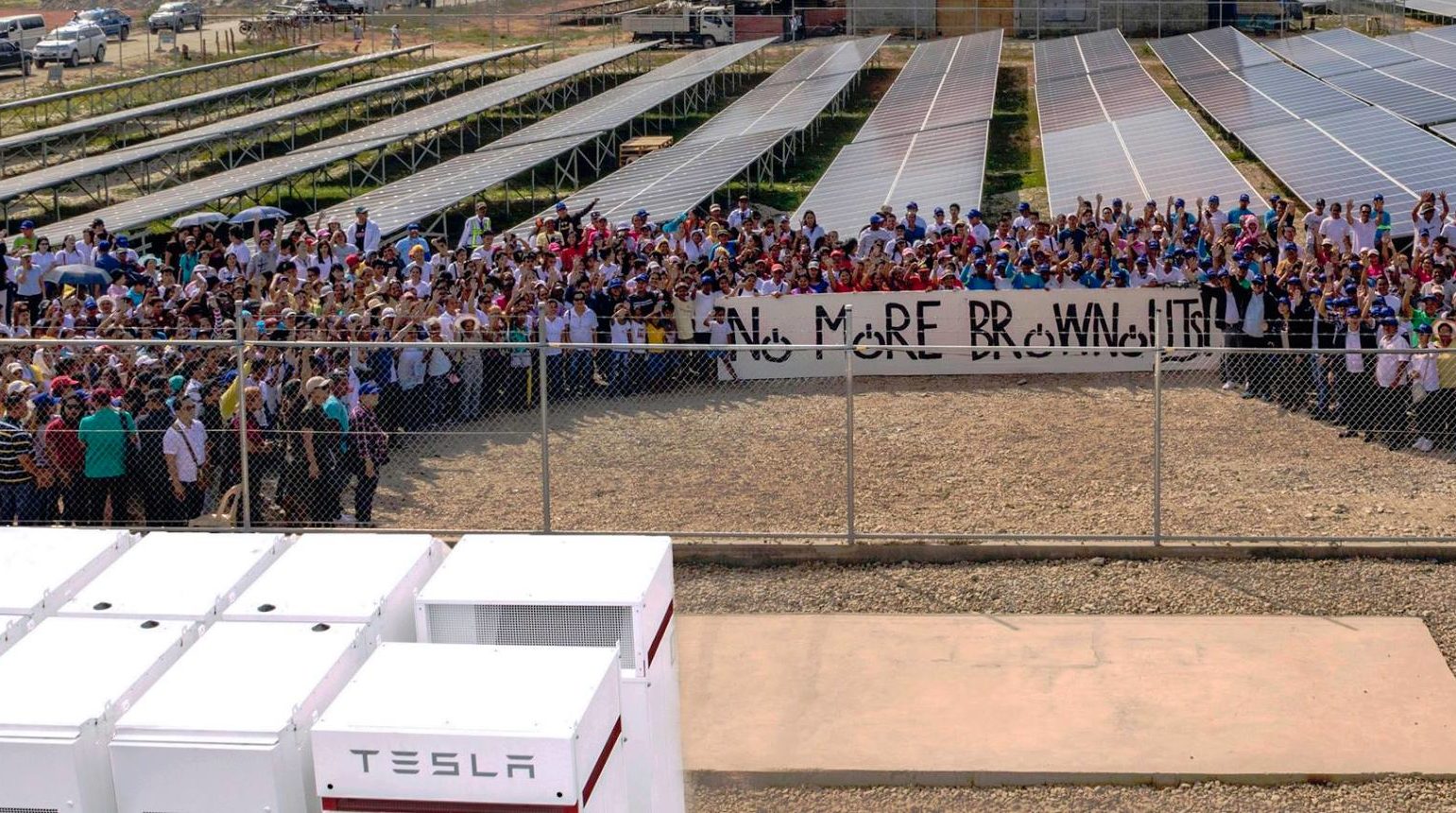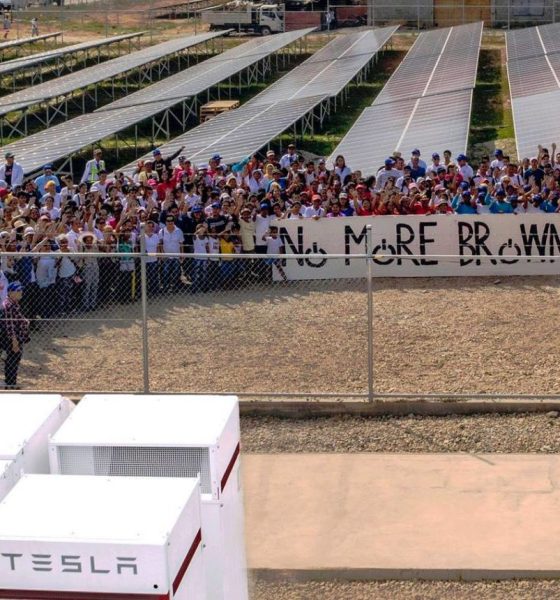

Energy
Tesla Powerpack batteries help Philippines town end longtime power crisis
Tesla has deployed its Powerpack batteries to the Philippines, helping a local solar company construct a 2MW/2MWh micro-grid for the town of Paluan, which has been suffering from notorious power outages for years. The project went online back in December, giving the town round-the-clock electric power for the first time.
To complete the project, Tesla partnered with local renewable energy company Solar Philippines. According to a report from Energy Storage News, Solar Philippines believes that the 2MW/2MWh will be enough to provide reliable power to the town’s residents 24 hours a day, at 50% less than the usual electricity costs. A 2MW diesel generator is on standby as well, ready to provide extra power when the need arises.
Solar Philippines founder Leandro Leviste believes that the Powerpack installation in Paluan would be the first of many renewable solutions in the country. The Solar Phils. executive further noted that “there is no reason” why other towns in the country would not follow suit, considering the cost benefits offered by solar-battery installations.

Tesla Powerpacks were installed on a small town in the Philippines. The term ‘brownouts’ seen in the banner is a local slang for power outages. [Credit: Solar Phils]
The benefits of the solar-battery system are notable. Thanks to the 2MW/2MWh micro-grid, the town’s residents were able to experience a Christmas absent of power outages for the first time. Schools in the area have also begun using computers. An ice plant, which would support the local fishermen, is also being planned. The town’s residents aired their gratitude to Solar Phils. and Tesla in a recent photograph, proudly declaring that there are no more power outages in the area since the batteries and solar arrays were installed.
The tiny town of Paluan, located just below the largest island in the Philippines, is home to around 16,000 people, according to a census conducted in 2015. The town is infamous for its struggles with electricity, with power outages becoming a part of its residents’ daily routines. The town first got electricity back in 1978, though the region’s grid was only able to provide power for 4 hours a day. This was improved in 2014, when the Philippines’ National Power Corporation was able to provide the town with electricity for 16 hours on a daily basis. Despite this improvement, however, power outages were still common, with some lasting for several days.
Tesla’s Powerpack systems have become game changers for areas with unstable electricity. Over the past few months, Tesla’s 100 MW/129 MWh big battery near Jamestown in South Australia had helped the region’s beleaguered energy grid hundreds of times, at one point even providing backup energy after a coal-powered plant unexpectedly experienced a power loss in December. Tesla had also announced other, more ambitious projects for the country, such as a 250 MW/650 MWh virtual power plant involving 50,000 residential units and Tesla Powerwall 2 batteries.
As we noted in a recent report, however, Tesla’s initiatives in South Australia are currently hitting roadblocks from the government, with newly-elected premier Steven Marshall stating that he would not support the company’s virtual power plant initiative. LNP senator and Minister for Resources Matt Canavan also dismissed Tesla’s efforts, calling the Powerpack farm near Jamestown the “Kim Kardashian” of energy.

Cybertruck
Tesla updates Cybertruck owners about key Powershare feature

Tesla is updating Cybertruck owners on its timeline of a massive feature that has yet to ship: Powershare with Powerwall.
Powershare is a bidirectional charging feature exclusive to Cybertruck, which allows the vehicle’s battery to act as a portable power source for homes, appliances, tools, other EVs, and more. It was announced in late 2023 as part of Tesla’s push into vehicle-to-everything energy sharing, and acting as a giant portable charger is the main advantage, as it can provide backup power during outages.
Cybertruck’s Powershare system supports both vehicle-to-load (V2L) and vehicle-to-home (V2H), making it flexible and well-rounded for a variety of applications.
However, even though the feature was promised with Cybertruck, it has yet to be shipped to vehicles. Tesla communicated with owners through email recently regarding Powershare with Powerwall, which essentially has the pickup act as an extended battery.
Powerwall discharge would be prioritized before tapping into the truck’s larger pack.
However, Tesla is still working on getting the feature out to owners, an email said:
“We’re writing to let you know that the Powershare with Powerwall feature is still in development and is now scheduled for release in mid-2026.
This new release date gives us additional time to design and test this feature, ensuring its ability to communicate and optimize energy sharing between your vehicle and many configurations and generations of Powerwall. We are also using this time to develop additional Powershare features that will help us continue to accelerate the world’s transition to sustainable energy.”
Owners have expressed some real disappointment in Tesla’s continuous delays in releasing the feature, as it was expected to be released by late 2024, but now has been pushed back several times to mid-2026, according to the email.
Foundation Series Cybertruck buyers paid extra, expecting the feature to be rolled out with their vehicle upon pickup.
Cybertruck’s Lead Engineer, Wes Morrill, even commented on the holdup:
As a Cybertruck owner who also has Powerwall, I empathize with the disappointed comments.
To their credit, the team has delivered powershare functionality to Cybertruck customers who otherwise have no backup with development of the powershare gateway. As well as those with solar…
— Wes (@wmorrill3) December 12, 2025
He said that “it turned out to be much harder than anticipated to make powershare work seamlessly with existing Powerwalls through existing wall connectors. Two grid-forming devices need to negotiate who will form and who will follow, depending on the state of charge of each, and they need to do this without a network and through multiple generations of hardware, and test and validate this process through rigorous certifications to ensure grid safety.”
It’s nice to see the transparency, but it is justified for some Cybertruck owners to feel like they’ve been bait-and-switched.
Energy
Tesla starts hiring efforts for Texas Megafactory
Tesla’s Brookshire site is expected to produce 10,000 Megapacks annually, equal to 40 gigawatt hours of energy storage.

Tesla has officially begun hiring for its new $200 million Megafactory in Brookshire, Texas, a manufacturing hub expected to employ 1,500 people by 2028. The facility, which will build Tesla’s grid-scale Megapack batteries, is part of the company’s growing energy storage footprint.
Tesla’s hiring efforts for the Texas Megafactory are hinted at by the job openings currently active on the company’s Careers website.
Tesla’s Texas Megafactory
Tesla’s Brookshire site is expected to produce 10,000 Megapacks annually, equal to 40 gigawatt hours of energy storage, similar to the Lathrop Megafactory in California. Tesla’s Careers website currently lists over 30 job openings for the site, from engineers, welders, and project managers. Each of the openings is listed for Brookshire, Texas.
The company has leased two buildings in Empire West Business Park, with over $194 million in combined property and equipment investment. Tesla’s agreement with Waller County includes a 60% property tax abatement, contingent on meeting employment benchmarks: 375 jobs by 2026, 750 by 2027, and 1,500 by 2028, as noted in a report from the Houston Business Journal. Tesla is required to employ at least 1,500 workers in the facility through the rest of the 10-year abatement period.
Tesla’s clean energy boom
City officials have stated that Tesla’s arrival marks a turning point for the Texas city, as it highlights a shift from logistics to advanced clean energy manufacturing. Ramiro Bautista from Brookshire’s economic development office, highlighted this in a comment to the Journal.
“(Tesla) has great-paying jobs. Not just that, but the advanced manufacturing (and) clean energy is coming to the area,” he said. “So it’s not just your normal logistics manufacturing. This is advanced manufacturing coming to this area, and this brings a different type of job and investment into the local economy.”
Energy
Tesla and Samsung SDI in talks over new US battery storage deal: report
The update was related by industry sources and initially reported by South Korean news outlets.

Recent reports have suggested that Tesla and Samsung SDI are in talks over a potential partnership to supply batteries for large-scale energy storage systems (ESS).
The update was related by industry sources and initially reported by South Korean news outlets.
ESS batteries to be built at Samsung’s Indiana plant
As noted in a report from Korea JoongAng Daily, the demand for energy storage systems has been growing rapidly in North America, thanks in no small part to the surge in AI investments across numerous companies. With this in mind, Tesla has reportedly approached Samsung SDI about a potential battery supply deal.
The deal is reportedly worth over 3 trillion Korean won (approximately $2.11 billion) and will span three years, according to The Korea Global Economic Daily. A battery supply deal with Samsung SDI could make sense for Tesla as the company already has a grid-scale battery, the Megapack, which is perfect for industrial use. Samsung SDI could simply supply cells for the EV maker.
Production of the batteries would reportedly take place at Samsung SDI’s joint venture factory with Stellantis in Indiana, which is currently under construction. Samsung SDI recently announced plans to use part of that plant’s EV lines to produce cells for ESS, with a targeted capacity of 30 GWh by the end of next year.
Tesla and Samsung’s partnership
At present, only a handful of manufacturers, including Korea’s LG Energy Solution, Samsung SDI, SK On, and Japan’s Panasonic, are capable of producing energy storage-scale batteries domestically in the United States. A Samsung SDI official issued a comment about the matter, stating, “Nothing has been finalized regarding cooperation with Tesla.”
The possible energy storage system deal adds another layer to Tesla’s growing collaboration with Samsung, which is already in line as a partner in the upcoming production of Tesla’s AI5 and AI6 chips. Early sample manufacturing of the AI6 is expected to begin in South Korea, with mass production slated for Samsung’s Texas-based Taylor foundry when it starts operations.
The AI6 chip will power Tesla’s next wave of high-volume projects, including the Optimus humanoid robot and the autonomous Cybercab service. Musk has called the partnership with Samsung a “real collaboration,” adding that he personally plans to “walk the line” at the Taylor facility to speed up progress.








